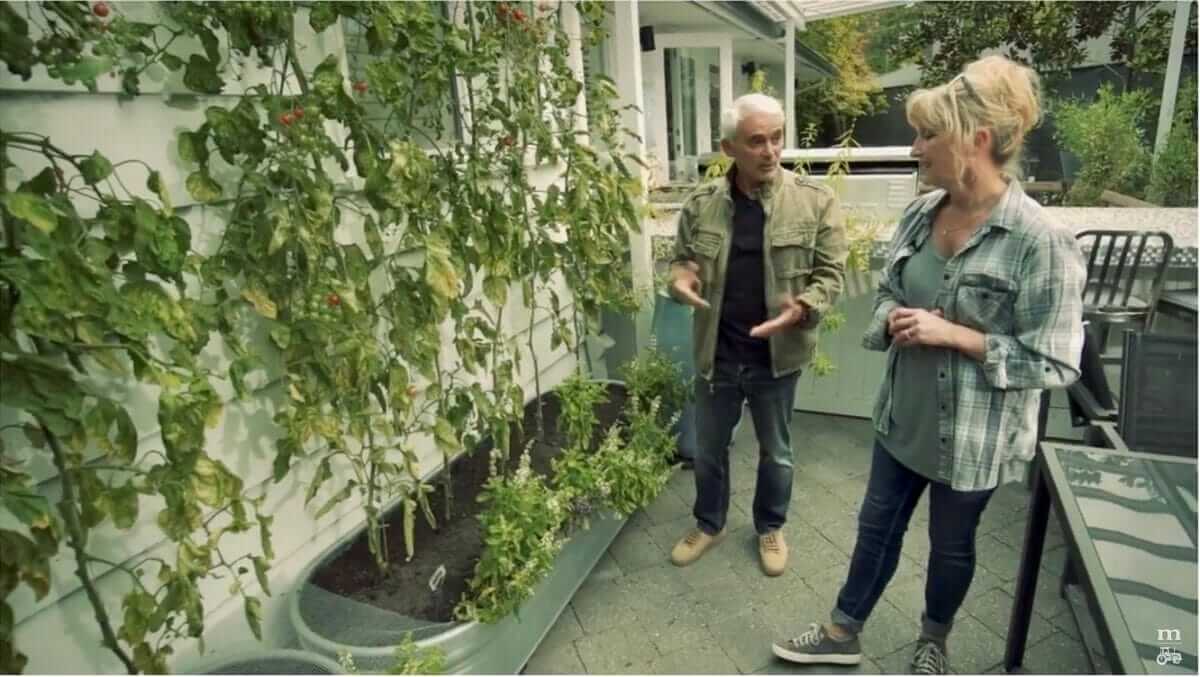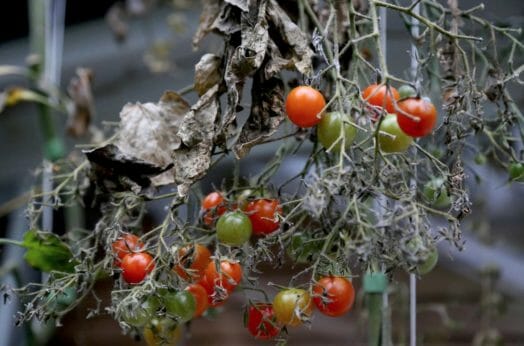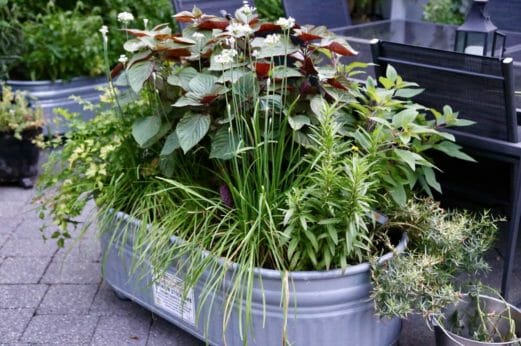Heat Sinks
You can think of heat sinks as heat traps of sorts, or thermal mass solar batteries that store daytime heat for release after sunset.
Heat Sinks
You can think of heat sinks as heat traps of sorts, or thermal mass solar batteries that store daytime heat for release after sunset.

Chatting about thermal mass and harnessing solar energy with Modern Farmer publisher Frank Giustra
It is rather extraordinary how a simple thing like hot stone can make the difference between a good tomato and a great tomato, outside or inside, in large spaces and very small spaces, especially in temperate climates with shorter growing seasons.
This corner patio garden of raised beds, protected somewhat from the elements by a sloping 12ft high glass roof with two open sides, and temperature-hacked by the combined thermal mass of the stone floor, stone fountain, heavy pottery, and the thick cedar-clad lath and plaster exterior walls of my home, is a tomato lovers dream come true. This was evidence late September, when during a day of filming segments for his new Permaculture Series, Modern Farmer publisher Frank Giustra and I returned time and again to this spot to chat about his favourite subject, tomatoes. Sungolds in particular, are his favourite cherry type tomatoes, and mine too. If you haven’t tried these tiny bright orange explosions of sweet candy sunshine, you must.
Like Syrah and Cabernet Sauvignon wine grapes, Sungold and other tomatoes benefit considerably from long warm days, supplemented by slow-drip solar heat delivered well into the night courtesy of low-slung stone. Growing grapes and tomatoes in rocky soil is of course one very celebrated way of capturing and storing solar energy for nighttime release, but stone pavers, stone planters, stone edging, raiser planters, buildings, and bulk water containment accomplish the same thing, to varying degrees.

You can think of heat sinks as heat traps of sorts, or thermal mass solar batteries that store daytime heat for release after sunset, as the outside temperature drops below the temperature of the stored energy. A material’s capacity to hold and release heat, as well as the time it takes to release it, is determined primarily by its Specific Heat Capacity (SHC), and secondarily by its sheer mass. The higher a material’s SHC, the more heat it can absorb.
Precise release rates factor into the equation also, but as I understand and have experienced it, a higher SHC indicates both a longer heating up time, and a longer cooling down time.
It’s the longer, controlled cooling down time that I aim for, because I know that during the peak growing months, summer days are long enough for the solar charge to take place without complication.
Where I live in the Pacific Northwest, we receive about 2000 hours of sunlight per year, with the prime growing months of July and August each receiving about 300 hours of sunlight, with average day and night time temperatures of 70F and 57F respectively.
I live on the edge of a temperate rainforest on the side of a mountain about 500ft above the ocean, and while it is lovely and green, it certainly isn’t Mediterranean tomato country. Heat sinks therefore are my friends.
Heat sink math isn’t exact for home gardeners, but we can keep in mind a few simple facts and rounded figures to help us plan for maximum solar gain, or conversely heat mitigation.
By combining one or more of these factors, we can hack summer well into early winter, which is what I have learned to do over several seasons experimenting with various combinations and arrangements of plantings on our back patio. The area of raised planters, where indeterminate Sweet 100s or Sweet Million and Sungold tomatoes are trellised to a height of 8-10ft, receives direct sunlight for less than six hours per day during July and August, yet yields one quart per day on average, from onset through early/mid November.

The area occupies the inside corner of an L-shaped leg of the house, rests on a two-inches of stone pavers, and is surrounded by large concrete pots, heavy glazed ceramic planters, deep raised beds on casters, a heavy stone fountain/birdbath, a marble-tiled outdoor kitchen counter, and the thick walls of my old house. Three or four 6-ft long by 18-inch wide stock feeders on casters are planted with anywhere from 15 to 20 tomato plants that I start indoors and then pot-up in the greenhouse starting in April. The cumulative thermal mass of these elements collects and traps heat during the cloudiest of days, and babies the tomatoes well past the best-before date of tomatoes grown in exposed garden beds far from supplementary radiant heat.
I water the soil (organic compost) at the base of the tomatoes, keeping the leaves and fruit dry and blight-free. Two or three varieties of basil are companion planted along the front of the raised beds, about 1ft away from the tomatoes, keeping insects at bay but still leaving room for watering just roots. Basil is fragile, and overhead watering can lead to what I call ‘mold and melt’ very quickly, especially when the weather turns cool for a spell. My daily routine over the summer, during early morning garden rounds, includes a visit to the tomatoes to harvest just the ripe fruit (yes fruit, not veg). I place my hand over each fully-coloured tomato that I believe to be ripe and pinch gently just behind the blossom greens, at the point where the fruit meets the small stem of its cluster. If the fruit pops off/pulls away easily, it is ripe, but if not I leave it for another day or two.
I sort the fruit into Sungolds and reds, then at the end of the week I de-stem the tomatoes, cut them in half, toss them in excellent quality olive oil and confit garlic oil (you can use purchased garlic oil), plus sea salt and a pinch of Calabrese chili flakes, and I place them cut side up on parchment-lined sheet pans to dry only partially in a 250F oven for two or three hours, until they have given up most of their moisture and concentrated their sweetness. You can of course use a dehydrator to dry tomatoes, but if you want to involve oil and spices, oven drying is the way to go. Every quart of fresh tomatoes yields more-or-less one 8oz freezer container of oven-dried tomatoes in oil.
I top each packed portion with a generous pour of beautiful olive oil and a small wreath of fresh oregano or sweet marjoram from the garden, snap on the lid and a label, and then freeze them for use throughout the following year. It is hard to describe just how delicious these oven-dried beauties are, and how happy they make my family during the cold and dark months of winter. Serving suggestion: toss together with olive oil and parmesan or pecorino as a simple pasta sauce, chop and add to plain tomato pasta sauce, serve on fresh bread, use in place of fresh tomato for crostini, serve warm over baked brie, garnish soups or grilled veg.
This year, I left the vines happily producing and ripening fruit, though increasingly slowly as fall progressed well into winter. Two weeks into November, I harvested several quarts of still-green tomatoes, and cut the vines down to the soil level, leaving the roots intact to compost-in-place. I transplanted some Swiss chard in between where the tomato plants had been, and left them to grow slowly together with the mache lettuce (corn salad) that I’d started from seed in the bed, immediately after cutting the last of the basil at the very end of September.
I took the green tomatoes inside to off-vine ripen inside shallow brown cardboard boxes placed inside brown paper grocery bags. The ethylene gas produced by the tomatoes as they ripen stays inside the bag, hastening the process, while oxygen passes freely through the paper. After less than a week I was able to sort a sheet pan full of ripe red and gold tomatoes from the boxes and dry them whole, very slowly in the oven. The indoor ripening had fortified the skin just slightly, allowing them to oven-dry without bursting, in much the same way one would dry grapes for raisins.
The resulting ‘tomato raisins’ were unique to the process of off-vine ripening indoors, in itself unique to late-harvested heat sink tomatoes, stretching every last bit of hope and possibility from the plants and resources used to grow them. By utilizing five of the 12 Permaculture Principles, namely: observation and interaction, catching and storing energy, utilizing renewable resources, creatively using and responding to change, and producing no waste, I utilize heat sinks to make the best of our relatively short summer. Granted I utilized my electric oven to dry the tomatoes, rather then a solar dryer, but such is the way of urban permaculture — we must bend and adapt and do our best with what we have.
I utilize thermal mass to capture and store solar energy in many other places throughout our urban permaculture garden as well, and for many other purposes. Along the south-facing bottom edge of our herb spiral, a small raised lavender berm planted up against the brick facade blooms more quickly and more robustly than lavender plants planted just one foot further away from the brick, just above them, and lavender planted at the very crown of the spiral, blooms still later.
Staged blooming is advantageous to bees and other pollinator insects that rely on our garden for habitat, and I in turn rely on pollinators to ensure that the berry bed and dwarf fruit orchard located very near to the herb spiral, set fruit. Heavy concrete planters throughout the garden encourage early-blooming lavender as well. Stone and concrete pots and planters help keep soil moist between waterings, doubling its solar energy absorption capacity.
Anyone at all with an outdoor space of any size, can utilize heat sinks to optimize solar energy. A small concrete planter, heat reflected from an inside wall, even maintenance of soil moisture can enhance performance and productivity. Windowsill gardens qualify too, as these very same principles apply.
Heat sinks, thermal mass, earth batteries, heat beds, solar greenhouses and many other hot topics allow permaculture designers and permaculture farmers to lean hard on renewable, natural resources without upsetting or harming the environment. All of us, no matter how or where in the world we live, can lean in a bit too. We can change our relationship with the natural world and take one small step toward sustainability. The collective power of millions of small gestures can indeed make a giant dent in the universe, and reverse the trajectory of catastrophic climate change. Imagine.
Follow us
This work is licensed under a Creative Commons Attribution-NoDerivatives 4.0 International License.
Want to republish a Modern Farmer story?
We are happy for Modern Farmer stories to be shared, and encourage you to republish our articles for your audience. When doing so, we ask that you follow these guidelines:
Please credit us and our writers
For the author byline, please use “Author Name, Modern Farmer.” At the top of our stories, if on the web, please include this text and link: “This story was originally published by Modern Farmer.”
Please make sure to include a link back to either our home page or the article URL.
At the bottom of the story, please include the following text:
“Modern Farmer is a nonprofit initiative dedicated to raising awareness and catalyzing action at the intersection of food, agriculture, and society. Read more at <link>Modern Farmer</link>.”
Use our widget
We’d like to be able to track our stories, so we ask that if you republish our content, you do so using our widget (located on the left hand side of the article). The HTML code has a built-in tracker that tells us the data and domain where the story was published, as well as view counts.
Check the image requirements
It’s your responsibility to confirm you're licensed to republish images in our articles. Some images, such as those from commercial providers, don't allow their images to be republished without permission or payment. Copyright terms are generally listed in the image caption and attribution. You are welcome to omit our images or substitute with your own. Charts and interactive graphics follow the same rules.
Don’t change too much. Or, ask us first.
Articles must be republished in their entirety. It’s okay to change references to time (“today” to “yesterday”) or location (“Iowa City, IA” to “here”). But please keep everything else the same.
If you feel strongly that a more material edit needs to be made, get in touch with us at [email protected]. We’re happy to discuss it with the original author, but we must have prior approval for changes before publication.
Special cases
Extracts. You may run the first few lines or paragraphs of the article and then say: “Read the full article at Modern Farmer” with a link back to the original article.
Quotes. You may quote authors provided you include a link back to the article URL.
Translations. These require writer approval. To inquire about translation of a Modern Farmer article, contact us at [email protected]
Signed consent / copyright release forms. These are not required, provided you are following these guidelines.
Print. Articles can be republished in print under these same rules, with the exception that you do not need to include the links.
Tag us
When sharing the story on social media, please tag us using the following: - Twitter (@ModFarm) - Facebook (@ModernFarmerMedia) - Instagram (@modfarm)
Use our content respectfully
Modern Farmer is a nonprofit and as such we share our content for free and in good faith in order to reach new audiences. Respectfully,
No selling ads against our stories. It’s okay to put our stories on pages with ads.
Don’t republish our material wholesale, or automatically; you need to select stories to be republished individually.
You have no rights to sell, license, syndicate, or otherwise represent yourself as the authorized owner of our material to any third parties. This means that you cannot actively publish or submit our work for syndication to third party platforms or apps like Apple News or Google News. We understand that publishers cannot fully control when certain third parties automatically summarize or crawl content from publishers’ own sites.
Keep in touch
We want to hear from you if you love Modern Farmer content, have a collaboration idea, or anything else to share. As a nonprofit outlet, we work in service of our community and are always open to comments, feedback, and ideas. Contact us at [email protected].by Laura Marie Neubert, Modern Farmer
November 26, 2020
Modern Farmer Weekly
Solutions Hub
Innovations, ideas and inspiration. Actionable solutions for a resilient food system.
ExploreExplore other topics
Share With Us
We want to hear from Modern Farmer readers who have thoughtful commentary, actionable solutions, or helpful ideas to share.
SubmitNecessary cookies are absolutely essential for the website to function properly. This category only includes cookies that ensures basic functionalities and security features of the website. These cookies do not store any personal information.
Any cookies that may not be particularly necessary for the website to function and are used specifically to collect user personal data via analytics, ads, other embedded contents are termed as non-necessary cookies.
Wow, tomato raisins! I must try this. Beautiful!!
We live in Michigan, and we are building tall raised bed gardens (36″) so I don’t have to bend over. We quickly realized the expense of filling them with gravel and soil would be cost prohibitive. We’re thinking of using a series of 15-gal drums filled with water and some anti-freeze, leaving head space in case they freeze, to fill the bottom 26″, then put a “false bottom” board, enclose it all with plastic sheeting, then put in our soil. Do think this will work as a heat sink, or will the water have the opposite effect? We’re debating about… Read more »